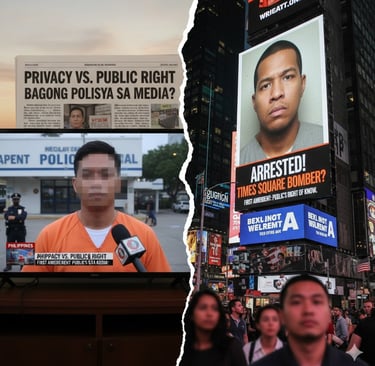A Tale of Two Media Approaches to Suspect Imagery
Blurred Lines vs. Public Scrutiny
THE EDITORIAL CHEESE
Patrick Petinglay Villavert
11/14/20253 min read


The recent controversy in the Philippines surrounding the blurring of Juanito Jose Remulla III's face after his arrest for drug possession sharply illuminates a fundamental difference in media practices and underlying legal philosophies compared to the United States. While the Philippines grapples with balancing privacy rights and the public's right to know, American media largely prioritizes the latter, backed by robust First Amendment protections.
The Philippine Approach: Prioritizing Privacy and Due Process
In the Philippines, the decision to blur the faces of arrested suspects, particularly in the Remulla case, is driven by a confluence of factors:
Law Enforcement Policy and Human Rights: Agencies like the Philippine Drug Enforcement Agency (PDEA) have implemented internal policies, reportedly rooted in the Data Privacy Act of 2012 and the constitutional right to the presumption of innocence. The argument is that publicly displaying an unconvicted suspect's face constitutes an undue invasion of privacy and can prejudice their right to a fair trial, effectively subjecting them to "trial by publicity" and public humiliation before guilt is proven.
Addressing Historical Abuses: This shift in policy can also be seen as a corrective measure to past practices, particularly during the "war on drugs," where suspects (often from marginalized communities) were routinely paraded before the media, unblurred, often with little regard for their rights. The Remulla case, while controversial for its perceived "special treatment," brought this ethical dilemma to the forefront.
Ethical Media Standards: Many Philippine media organizations adhere to ethical guidelines that encourage blurring faces, especially for minors and victims. The recent controversy has pushed for more consistent application of this standard across all suspects.
While this approach aims to protect individual rights, critics argue it can hinder justice by preventing other victims or witnesses from identifying suspects and reducing public transparency in high-profile cases.
The American Approach: The Unblurred Face of Transparency
In stark contrast, American media generally operates under the principle that the faces and mugshots of adult arrestees are public information, to be published unblurred. This practice is deeply embedded in the legal and cultural landscape of the United States, primarily due to the First Amendment of the Constitution.
The Rationale Behind Strong First Amendment Rights:
The First Amendment states, "Congress shall make no law... abridging the freedom of speech, or of the press..." This powerful protection underpins the American media's approach:
Watchdog Function (Public's Right to Know): A cornerstone of American democracy is the belief that a free and unfettered press serves as a "watchdog" over government and public institutions, including law enforcement and the justice system. Publishing details about arrests, including mugshots, is seen as essential for transparency, allowing the public to monitor police conduct, identify potential abuses, and hold officials accountable.
Curbing Abuse of Power: The ability to report on who is arrested, by whom, and for what reason is a critical check against arbitrary arrests, false charges, or corruption within law enforcement. An informed citizenry is better equipped to challenge injustice.
Facilitating Public Discourse: By providing comprehensive information, including the identities of those involved in public events or criminal matters, the media fosters informed public debate about crime, justice, and social issues.
Presumption of Public Records: In most U.S. states, arrest records, including mugshots, are considered public records accessible to the media and the general public under freedom of information laws. The legal precedent overwhelmingly favors public access over individual privacy in these contexts.
The Blurring Debate in the US: A Shifting Tide
While the default in the U.S. remains unblurred publication, the digital age has sparked a growing ethical debate. The permanence of online mugshots, and the irreparable harm they can inflict even on those later exonerated, has led to:
Ethical Shifts in Journalism: Some media outlets are now voluntarily adopting policies to remove mugshots of individuals whose charges are dropped or who are acquitted.
Legislative Efforts: Some states are passing laws to restrict law enforcement from publicly releasing mugshots for certain minor or non-violent offenses, recognizing the "digital scarlet letter" effect.
Consistent Blurring for Minors and Victims: American media consistently blurs the faces of minors (both victims and suspects) and victims of sensitive crimes, aligning with privacy concerns in those specific contexts.
Conclusion: Two Paths, One Goal?
The contrast between media practices in the Philippines and the United States reflects different interpretations of where the balance lies between individual privacy rights and the public's right to transparency in the justice system.
The Philippines, seemingly moving towards a more privacy-centric approach for all suspects (though inconsistently applied in the past), emphasizes the constitutional presumption of innocence. The U.S., with its robust First Amendment, prioritizes the media's role in public scrutiny, even as it grapples with the unintended consequences of digital permanence. Both systems, in their unique ways, seek to uphold justice, but their methods highlight the complex, evolving challenge of defining what constitutes a "fair" and "transparent" criminal justice system in the modern era.
